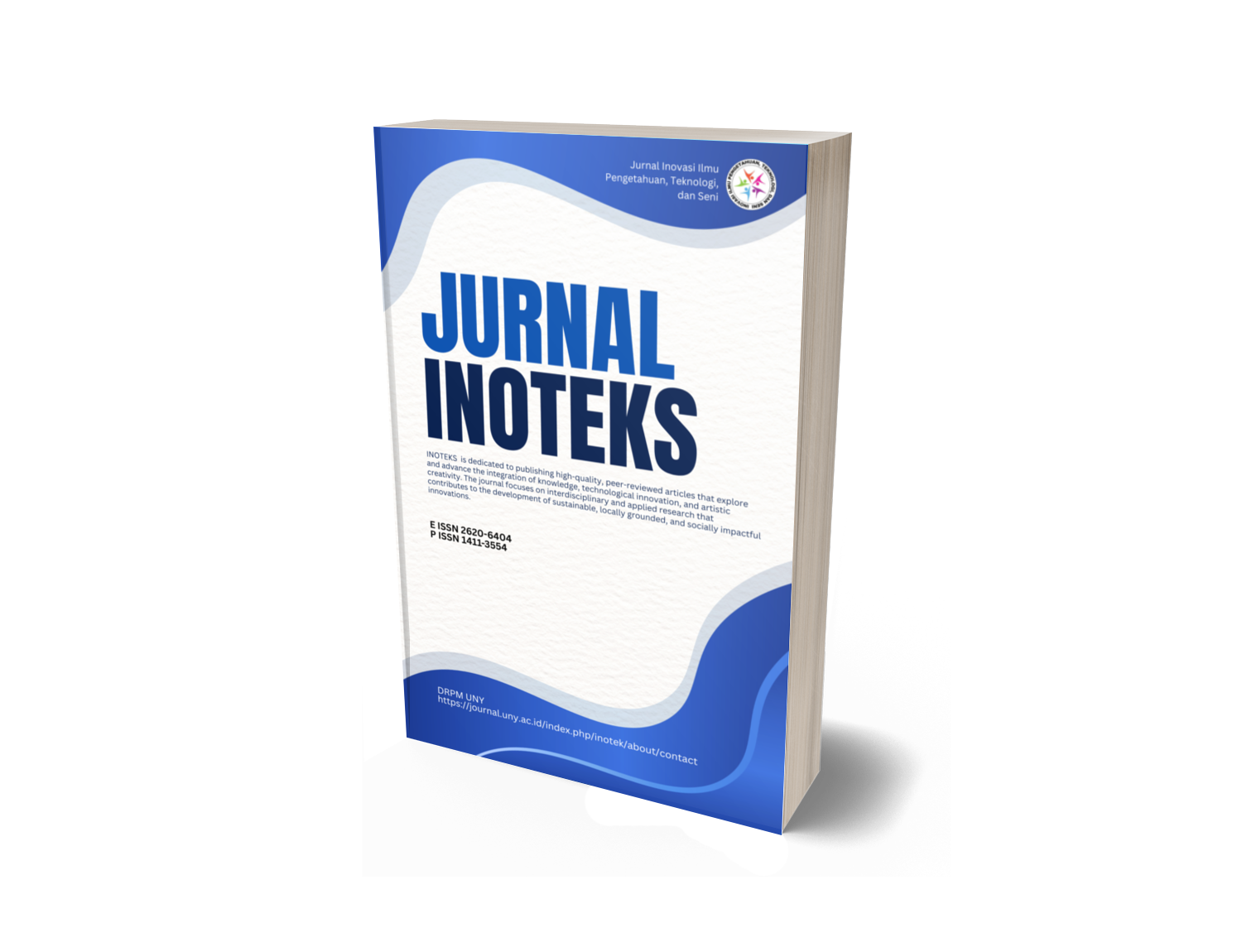Pengembangan kriya perca kolaborasi ragam hias Bintang Na Toras Mandailing dan bunga teratai Cina
DOI:
https://doi.org/10.21831/ino.v28i2.45330Keywords:
Sinta, ISJD, google schoolar.Abstract
Student creativity activities in industrial engineering lectures are in the form of developing patchwork dining table cloths in collaboration with the Na Toras Mandailing Star and Chinese Lotus Flowers. The purpose of this activity is to improve students' knowledge and skills in designing home industries, especially handicrafts on household linen. The methodology used in this scientific work is in the form of a qualitative explosive method. There are several stages in the process of the handicraft home industry, namely; 1) Able to create a concept map of the organizational structure of the home-based craft industry, 2) Able to create a craft-pattern design concept, 3) Able to develop manual drawing sketches, 4) Able to create innovative motifs, and 5) Able to apply motifs to cloth-pattern crafts dining table. This scientific work produces an ethnic and innovative form of home industry design for handicrafts on the dining table cloth.
Keywords: Development, craft, patchwork, Mandailing, China.
References
Alfi Yusrina Farikha. (2020). The Existence of Indonesian Craft in the Middle of DiY Craft Movement by Millennial Community, Published by Atlantis Press SARL. DOI:10.2991/assehr.k.200323.060.
Aleksandar Damnjanovic. (2016). LEARNING AND DEVELOPMENT IN MODERN ORGANIZATIONS. International Conference "žEconomics and Management – Based on New Technologies" – EmoNT. https://www.researchgate.net/publication/309134383.
Rasa Suntrayuth. (2016). Collaborations and Design Development of Local Craft Products: Service Design for Creative Craft Community, The Journal of Creative and Arts Studies (IJCAS). Vol.3, No.2. DOI: https://doi.org/10.24821/ijcas.v3i2.
Sinikka Pí¶llänen.(2012). The meaning of craft. Craft makers' descriptions of craft as an occupation. Scandinavian Journal of Occupational Therapy. DOI:10.3109/11038128.2012.725182.
Feldman, Edmund Bruke. (1991). Ar Ast Image and Idea, terj., SP. Gustami, Fakultas Seni Rupa dan Disain, Institut Seni Indonesia, Yogyakarta.
Muhammad Kristiawan. (2019). Module Development The Utilization Of Patchwork Fabric As Teaching Materials Crafts On The Subjects Of Craft And Entrepreneurship For High School Students. International Journal of Scientific & Technology Research 8(5):124-130https://www.researchgate.net/publication/335566426.
Hamdani Hamid.( 2013). Pengembangan Sistem Pendidikan di Indonesia, (Bandung : Pustaka Setia,). h. 125.
Vera John Steiner. (2006). Creative Collaboration. Published to Oxford Scholarship Online.
DOI:10.1093/acprof:oso/9780195307702.001.0001.
Paul Paulus. (2012). Collaborative Creativity-Group Creativity and Team Innovation. Handbook of Organizational Creativity (pp.327-357).
Agus Sachari, (2001). Desain dan Dunia Kesenirupaan Indonesia dan Wacana Transformasi Budaya. Bandung: ITB.
Prihati, S. (2013). Dasar Teknologi Menjahit 1. Direktorat Pembinaan Sekolah Menengah Kejuruan.
Van Der Hoop, (1949). Ragam-ragam perhiasan Indonesia. Koninklijk Bataviaasch Genootschap Van.
Wacius Wong. (1995). Beberapa Asas Menggambar Dwimatra. Bandung: Penerbit ITB.
Hamzah B.Uno.(2011). Model Pembelajaran Menciptakan Proses Belajar Mengajar yang Kreatif dan Efektif. Jakarta: Bumi Aksara. h. 129.
Trianto. (2009). Mendesain Model Pembelajaran Inovatif-Progresif. Jakarta: Kencana Media Group. h. 201.
Downloads
Published
How to Cite
Issue
Section
Citation Check
License
- Authors certify that the work reported here has not been published before and contains no materials the publication of which would violate any copyright or other personal or proprietary right of any person or entity.
- Authors transfer or license the copyright of publishing to Jurnal Civics: Media Kajian Kewarganegaraan to publish the article in any media format, to share, to disseminate, to index, and to maximize the impact of the article in any databases.
- Authors hereby agree to transfer a copyright for publishing to Jurnal Civics: Media Kajian Kewarganegaraanas a Publisher of the manuscript.
- Authors reserve the following:
- all proprietary rights other than copyright such as patent rights;
- the right to use all or part of this article in future works of our own such as in books and lectures;
- use for presentation in a meeting or conference and distributing copies to attendees;
- use for internal training by author's company;
- distribution to colleagues for their research use;
- use in a subsequent compilation of the author's works;
- inclusion in a thesis or dissertation;
- reuse of portions or extracts from the article in other works (with full acknowledgement of final article);
- preparation of derivative works (other than commercial purposes) (with full acknowledgement of final article); and
- voluntary posting on open web sites operated by author or author's institution for scholarly purposes, but it should follow the open access license of Creative Common CC BY-NC-SA License.








